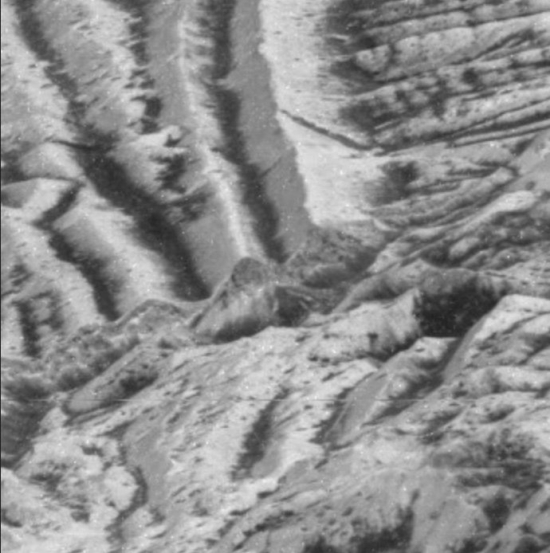Yesterday we looked at the behavior of ice on Enceladus, a key to making long range plans for a lander there. But as we saw with Kira Olsen and team’s work, learning about the nature of ice on worlds with interior oceans has implications for other ice giant moons. This morning we look at the hellish surface environment of Europa, as high-energy radiation sleets down inside Jupiter’s magnetic field.
Europa’s surface radiation will complicate operations there and demand extensive shielding for any lander. But below the ice, that interior ocean should be shielded and warm enough to offer the possibility of life. With Europa Clipper on pace for a 2024 launch, we need to ask how the surface ice has been shaped and where we might find biosignatures that could have been churned up from below.

Tidal stresses on the ice leading to fracture are one way to force material up, but small impacts from above — debris in the Jovian system — also roil the surface. If we’re looking for potential biosignatures, we have to consider this surface churn and the effects of radiation upon what it produces. This is the subject of new work from a team led by Emily Costello (University of Hawai?i at Manoa), which has been studying the effects of electron radiation accelerated by Jupiter on complex molecules.
Image: The University of Hawai?i at Manoa’s Costello. Credit: UH Manoa.
The operative term in this paper, just published in Nature Astronomy, is impact gardening. The authors estimate through their modeling that the surface of Europa has been affected up to an average depth of 30 centimeters (about 12 inches). Over millions of years, the impacts add up even as surface material mixes with the subsurface, all bathed by radiation.
“If we hope to find pristine, chemical biosignatures, we will have to look below the zone where impacts have been gardening,” says Costello. “Chemical biosignatures in areas shallower than that zone may have been exposed to destructive radiation.”

Image: In this zoomed-in area (Figure 2) of Europa’s surface, an inset to Figure 1, a cliff runs across the middle of the image, revealing the interiors of the ridges leading up to it. The thin, bright layer at the top of the cliff is at least 20 to 40 feet (6 to 12 meters) thick. This thin surface layer, and possibly layers like it elsewhere over Europa’s surface, is where a process called “impact gardening” is thought to occur. Impact gardening is the small-scale mixing of the surface by space debris, such as asteroids and comets. Scientists are studying the cumulative effects of small impacts on Europa’s surface as NASA prepares to explore the moon with the upcoming Europa Clipper mission. New research and modeling estimate that the surface of Europa has been churned by small impacts to an average depth of about 12 inches (30 centimeters), within the layer of the surface that is visible here. Credit: NASA/JPL-Caltech.
The study looks not only at surface impacts but goes on to consider secondary impacts when debris returns to the surface after the initial strike. We learn there is a case for a particular zone on Europa — the moon’s mid- to high-latitudes — that would be less affected by radiation. In any case, a robotic lander may need to probe at least 30 centimeters down to find material unaffected by the ongoing impact gardening.
Rebecca Ghent (Planetary Science Institute, Tucson) is a co-author on the study:
“The work in this paper could provide guidance for design of instruments or missions seeking biomolecules; it also provides a framework for future investigation using higher-resolution images from upcoming missions, which would help to generate more precise estimates on the depth of gardening in various specific regions. The key parameters in this study are the impact flux and cratering rates. With better estimates of these parameters, and higher-resolution imaging resulting from upcoming missions, it will be possible to better predict the depths to which gardening has affected the shallow ice in specific regions.”
As a side note, I found when looking through Costello’s other papers that she and Ghent have done work on impact gardening at Ceres as well as Mercury and our own Moon. The paper on Ceres argues that the phenomenon is orders of magnitude less intense on Ceres than on the Moon, involving a much thinner regolith and leaving surface ice to be affected primarily by sublimation rather than impacts. It seems clear that our work on icy gas giant moons will need to take impact gardening into consideration, just as we monitor the movement of crustal ice.
The paper is Costello et al., “Impact gardening on Europa and repercussions for possible biosignatures,” Nature Astronomy 12 July 2021 (abstract). The paper on Ceres is Costello et al., “Impact Gardening on Ceres,” Geophysical Research Letters 11 April 2021 (abstract).



The assumption being that life will be present in the plumes which will fall back onto the surface? If that is the case, an orbiter diving through the plume may be better suited to detecting life.
If, however, there is upwelling that just flows from a vent onto the surface, that might be a better reason to look below the gardening layer.
However, 30 cm is just 12 inches. I suspect the intense radiation penetrates below that depth, a meter to maybe 10 meters depending on radiation intensity. As the radiation creates hydrogen peroxide which will degrade any organic material, this should mean that organics will be degraded throughout the crust that is built up of successive layers of new material from the plumes and other surface sources. Peroxides will remain in that snow and ice. If so, looking for biosignatures might be very difficult in the icy crust. Fresh material in a plume, perhaps emerging from the crust might be the best place – unexposed to radiation until exiting the vent.
Perhaps detecting a gas like H2S might be a better biosignature for rather than traditional organic materials, unless whole organisms or fragments can be captured before they are degraded.
Hopes of finding near surface biosignatures on Europa have long been a source of frustration for me. I’m gratified that newer research has dampened down that early optimism but imo the chances of finding intact biosignatures on Europa’s surface will fall victim to the combined forces of high level radiation and long time scales.
The Europan surface receives 5.4 Sv of radiation per day on average. A figure thousand of times higher than the surface of Mars. This is mainly due to locally accelerated particles in Jupiter’s magnetic environment. Studies have long shown (eg. https://pubmed.ncbi.nlm.nih.gov/22349404/) that biosignatures degrade to the point of complete dissolution when exposed to doses exceeding ~150 kGy. This dose equivalent will be reached in very short time frames on Europa even at 30cm depth. Add to that the effects of continual bombardment of GCR which penetrate much much deeper. This is the core of my critique.
If one posits that plume deposition could be a possible source of surface biosigs the outlook becomes even bleaker. Deposition rates at Enceladus(https://iopscience.iop.org/article/10.3847/PSJ/abf2c5#:~:text=The%20average%20deposition%20rate%20is,2019) are orders of magnitude higher(at present) than any rates proposed for Europa. And even at the proposed highest rate of 0.1mm/yr adjacent to the Tiger Stripes on Enceladus, equivalent rates on Europa the would not he sufficient to bury the bio substances fast enough to avoid their complete signal erasure be exposed in short order.
Where intact biosigs could be detected in the upper ice shell is for me a mystery. Perhaps if regions like the Chaos Terrain actually contain swelled up ocean water then perhaps there might be a chance to extract intact samples from 10’s of meters depth. Unfortunately, recent simulations indicate that the Chaos Terrain was caused by surface adjacent disruption separate and distinct from the subsurface ocean.
Here’s to hoping that the alien microbes can rustle up enough energy to fabricate some
hardier body components, thereby giving us a better chance to spot them.
Excellent point. The Wikipedia entry on diatoms indicates that evolved quite late, perhaps as early as the Permian. What the evolutionary advantage is, is not clear, although I can imagine that digesting such organisms might be a problem for predators.
Other external skeletal materials such as carbonates (c.f. coccoliths) might also be quite resistant.
If either exists, then it implies that any Europan life has advanced beyond prokaryotes if they follow a similar evolutionary path to that on Earth (although we should not assume evolution follows the same path as on Earth).
My thoughts are that unless we find clear evidence of biomolecules by orbital craft capturing plume material on orbital passes, the question of looking for biosignatures on, or just below the surface, the surface is moot.
Has anyone done experiments on vacuum flash freezing to see whether organisms can survive the freezing as the plume material emerges into a vacuum? We know that radiation, primarily UV and gamma) can sterlize foods (I recall the controversy over this technique), and that peroxide kills bacteria effectively. But has anyone done simulations of the Europan environment to determine which, if any, organisms, cell structures, and biomolecules can survive for detection by instruments? It would seem a relatively low-cost series of experiments to do in order to determine which instruments should be added to any flyby, orbital, or lander.
Ionizing radiation is not good for keeping complex molecules stable yet per an earlier post, it can act as an energy source for living organisms. When does ionizing radiation destroy and when can it provide energy to drive an ecosystem?
Presumably there is a balance somewhere. For subsurface organisms, any external source of radiation, whether UV light or charged particles is blocked by the medium separating the organism from the source. Hence even on the early Earth, organisms can avoid the harsh UV reaching the surface before the O3 was present simply by staying below the marine surface.
If the icy crust surface was static, the same would apply to Europa. However, the radiation creates oxidizing molecules like H2O2 which would remain in the snow and ice and as the surface is built up with new material, these molecules would be pushed down from the surface. This would seem to remove the barrier effect of the surface ice.
If there was life on Europa, I would think that it would be confined to the oceans, and any O2 from the peroxide would then slowly enter the ocean from the bottom of the ice crust. However, the amount of energy this provides is a tiny fraction of the energy the Earth’s surface receives from the sun, although it may be greater than the energy received by Earth’s radioactive decay. (I need to look up those numbers).
The issue at hand is detecting that life. The hope is that organisms caught up in a plume can be detected before the freezing and radiation destroy the molecules that would indicate life. This paper suggests that they will not be conveniently laying around on the surface as “gardening” will create continual mixing and exposure to the surface radiation to at least 30 ncm deep on average. The question is whether the radiation and the oxidizing molecules destroying the biomolecules operates at a much deeper level than that.
Excellent point- “Europa’s surface radiation will complicate operations there and demand extensive shielding for any lander.”
Considering how the Mars landers develop a mantle of dust fairly quickly, perhaps it makes sense to adopt a “hermit crab strategy” for a Europa lander, so instead of BRINGING the heavy shielding, the lander collects Europa surface material and builds a shield from local materials?